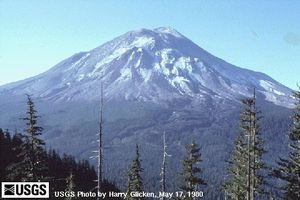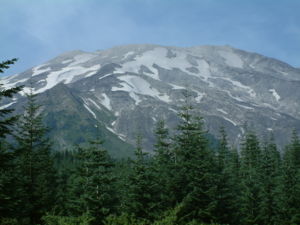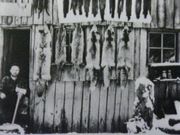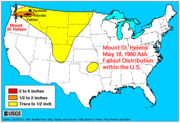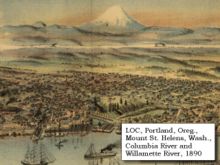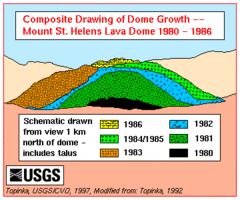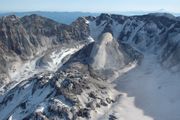Mount St. Helens
2007 Schools Wikipedia Selection. Related subjects: North American Geography
| Mount St. Helens | |
|---|---|
 3,000 ft (1 km) steam plume on May 19, 1982 |
|
| Elevation | 8,364 ft (2,550 m) |
| Location | Washington, USA |
| Range | Cascades |
| Coordinates | |
| Topo map | USGS Mount St. Helens |
| Type | Active stratovolcano, otherwise known as composite volcano |
| Age of rock | < 40,000 yrs |
| Last eruption | 2004-2006 (ongoing) |
| First ascent | 1853 by Thomas J. Dryer |
| Easiest route | Hike via south slope |
Mount St. Helens is an active stratovolcano in Skamania County, Washington, in the Pacific Northwest region of the United States. It is located 96 miles (154 km) south of the city of Seattle and 53 miles (85 km) northeast of Portland, Oregon. The mountain, part of the Cascade Range, takes its English name from the British diplomat Lord St Helens, who was a friend of George Vancouver, an explorer who made a survey of the area in the late 18th century. Mount St. Helens is a part of the Pacific Ring of Fire that includes over 160 active volcanoes. This volcano is well known for its ash explosions and pyroclastic flows.
Mount St. Helens is most famous for its catastrophic eruption on May 18, 1980 at 08:32 Pacific Standard Time. The eruption was the most deadly and economically destructive volcanic event in the history of the United States. (In 1912, Mount Katmai, Alaska, was the site of the largest volcanic eruption in U.S. history.) Fifty-seven people were killed; 250 homes, 47 bridges, 15 miles (24 km) of railways and 185 miles (300 km) of highway were destroyed. The eruption caused a massive debris avalanche, reducing the elevation of the mountain's summit from 9,677 feet (2,950 m) to 8,364 feet (2,550 m), and replacing it with a mile-wide (1.5 km-wide) horseshoe-shaped crater. The debris avalanche was up to 0.7 cubic miles (2.3 km³) in volume, making it the largest in recorded history. However, the scale of the blast pales in comparison with debris avalanches that have occurred in the geological past elsewhere on Earth.
Like most other volcanoes in the Cascade Range, Mount St. Helens is a great cone of rubble consisting of lava rock interlayered with ash, pumice and other deposits. The mountain includes layers of basalt and andesite through which several domes of dacite lava have erupted. The largest of the dacite domes formed the previous summit; another formed Goat Rocks dome on the northern flank. These were destroyed in the eruption of 1980.
Geographic setting and description
Mount St. Helens is located 34 miles (55 km) almost due west of Mount Adams, in the eastern part of the Cascade Range. These "sister and brother" volcanic mountains are each about 50 miles (80 km) from Mount Rainier, the giant of Cascade volcanoes. Mount Hood, the nearest major volcanic peak in Oregon, is about 60 miles (95 km) southeast of Mount St. Helens.
Mount St. Helens is geologically young compared to the other major Cascade volcanoes. It was formed only within the last 40,000 years, and the pre-1980 summit cone started to grow only about 2,200 years ago. The volcano has also been the most active in the Cascades during the Holocene (the last 10,000 or so years).
Even before its loss of height, Mount St. Helens was not one of the highest peaks in the Cascade Range; its summit altitude made it only the fifth-highest peak in Washington. It stood out prominently, however, from surrounding hills because of the symmetry and extensive snow- and ice-cover of the pre-1980 summit cone, earning it the nickname, "Fujiyama of America" (" Mount Fuji of America"). The peak rose more than 5,000 feet (1,500 m) above its base, where the lower flanks merge with adjacent ridges. The mountain is about 6 miles (9.5 km) across at its base, which is at an altitude of about 4,400 feet (1,340 m) on the northeastern side and about 4,000 feet (1,220 m) elsewhere. At the pre-eruption tree-line the width of the cone was about 4 miles (6.4 km).
Streams that start on the volcano enter three main river systems: the Toutle River on the north and north-west, the Kalama River on the west, and the Lewis River on the south and east. The streams are fed by abundant rain and snow. The average annual rainfall is 140 inches (3.6 m), and the snowpack on the mountain's upper slopes can reach 16 feet (4.9 m). The Lewis River is impounded by three dams for hydroelectric power generation. The southern and eastern sides of the volcano drain into an upstream impoundment, the Swift Reservoir, which is directly south of the volcano's peak.
Although Mount St. Helens is in Skamania County, Washington, the best access routes to the mountain run through Cowlitz County, Washington on the west. Washington State Route 504, locally known as the Spirit Lake Memorial Highway, connects with the heavily traveled Interstate 5 at Exit 49, about 34 miles (55 km) to the west of the mountain. That major north-south highway skirts the low-lying cities of Castle Rock, Longview and Kelso along the Cowlitz River, and passes through the Vancouver, Washington- Portland, Oregon metropolitan area less than 50 miles (80 km) to the southwest. The community nearest the volcano is Cougar, Washington, in the Lewis River valley about 11 miles (18 km) south-southwest of the peak. Gifford Pinchot National Forest surrounds Mount St. Helens.
Human history
Importance to Native Americans
Traces of ancient campsites have been found in the Gifford Pinchot National Forest that surrounds the monument. These show that people have lived in this area for at least 6500 years. Throughout human history, Mount St. Helens eruptions have had a dramatic effect on the lives of local inhabitants. Work by archaeologists has shown that a massive eruption 3500 years ago buried Native American settlements with a thick layer of pumice. This caused the people to abandon their mountain territory for nearly 2000 years. In more recent times, Native Americans of the Cowlitz, Taidnapam, Klickitat, Upper Chinook, and Yakama tribes moved over the land in a seasonal pattern. They harvested huckleberries, salmon, elk, and deer.
Native American lore contain numerous legends to explain the eruptions of Mount St. Helens and other Cascade volcanoes. Perhaps the most famous of these is the Bridge of the Gods legend told by the Klickitats. In their tale, the chief of all the gods, Tyhee Saghalie and his two sons, Pahto (also called Klickitat) and Wiyest, traveled down the Columbia River from the Far North in search for a suitable area to settle.
They came upon an area that the white men now call The Dalles and thought they had never seen a land so beautiful. The sons quarreled over the land and to solve the dispute their father shot two arrows from his mighty bow; one to the north and the other to the south. Pahto followed the arrow to the north and settled there while Wyest did the same for the arrow to the south. Saghalie then built Tanmahawis, the Bridge of the Gods, so his family could meet periodically.
When two sons of the Saghalie fell in love with a beautiful maiden named Loowit, she could not choose between them. The two young chiefs fought over her, burying villages and forests in the process. The area was devastated and the earth shook so violently that the huge bridge fell into the river, creating the cascades of the Columbia River Gorge.
For punishment, Sahale struck down each of the lovers and transformed them into great mountains where they fell. Wyeast, with his head lifted in pride, became the volcano known today as Mount Hood and Pahto, with his head bent toward his fallen love, was turned into Mount Adams. The fair Loowit became Mount St. Helens, known to the Klickitats as Louwala-Clough which means "smoking or fire mountain" in their language (the Sahaptin called the mountain Loowit).
Exploration by Whites
Royal Navy Commander George Vancouver and the officers of HMS Discovery made the Europeans' first recorded sighting of Mount St. Helens, on May 19, 1792, while they were surveying the northern Pacific Ocean coast. Vancouver named the mountain for British diplomat Alleyne Fitzherbert, 1st Baron St Helens on October 20, 1792, as it came into view when the Discovery passed into the mouth of the Columbia River.
Years later, explorers, traders, and missionaries heard reports of an erupting volcano in the area. Geologists and historians determined much later that the eruption took place in 1800, marking the beginning of the 57-year-long Goat Rocks Eruptive Period (see geology section). Alarmed by the "dry snow", the Nespelem tribe of northeastern Washington spent a great deal of time in prayer and dance instead of collecting food, and therefore suffered a hard winter.
In late 1805 and early 1806, members of the Lewis and Clark Expedition spotted Mount St. Helens from the Columbia River but did not report an ongoing eruption, or recent evidence of one. They did report the presence of quicksand and clogged channel conditions at the mouth of the Sandy River near Portland, suggesting an eruption by Mount Hood sometime in the previous decades.
White settlement and use of the area
The area's first non-Native American inhabitants were the fur traders and trappers. Most of these men worked for the fur trading enterprise of the British-owned Hudson's Bay Company. In the early 1890s, Ole' Peterson set up housekeeping at Cougar Flats, on the Upper Lewis River. He was a true hermit--preferring to keep to himself, and enjoying the quiet solitude of nature.
Also in the early 1890s, a 156 square mile mining district north of Spirit Lake was established. By 1911, over 400 mining claims had been filed. However, the minerals were never found in quantities large enough to be profitable. Much effort was spent in attempting to get a road or railroad built into the district. None ever came. By 1911, it was clear that there were no veins of precious minerals rich enough to offset the high transportation costs.
The first authenticated eyewitness report of a volcanic eruption was made in March 1835 by Dr. Meredith Gairdner, while working for the Hudson's Bay Company stationed at Fort Vancouver. He sent an account to the Edinburgh New Philosophical Journal, which published his letter in January 1836. James Dwight Dana of Yale University, while sailing with the United States Exploring Expedition, saw the then-quiescent peak from off the mouth of the Columbia River in 1841. Another member of the expedition later described "cellular basaltic lavas" at the mountain's base.
In late fall or early winter of 1842, nearby settlers and missionaries were witness66 to the so-called "Great Eruption". This small-volume outburst created large ash clouds, and mild explosions followed for 15 years. The eruptions of this period were likely phreatic ( steam explosions). The Reverend Josiah Parrish in Champoeg, Oregon witnessed Mount St. Helens in eruption on November 22, 1842. Ash from this eruption may have reached The Dalles, Oregon, 48 miles (80 km) southeast of the volcano.

In October 1843, future California governor Peter H. Burnett recounted a story of a Native American man who badly burned his foot and leg in lava or hot ash while hunting for deer. The likely apocryphal story went that the injured man sought treatment at Fort Vancouver but the contemporary fort commissary steward, Napolean McGilvery, disclaimed knowledge of the incident. British lieutenant Henry J. Warre sketched the eruption in 1845, and two years later Canadian painter Paul Kane created watercolors of the gently smoking mountain. Warre's work showed erupting material from a vent about a third of the way down from the summit on the mountain's west or northwest side (possibly at Goat Rocks), and one of Kane's field sketches shows smoke emanating from about the same location.
On April 17, 1857, the Republican, a Steilacoom, Washington newspaper, reported that "Mount St. Helens, or some other mount to the southward, is seen ... to be in a state of eruption". The lack of a significant ash layer associated with this event indicates that it was a small eruption. This was the first reported volcanic activity since 1854.
Before the 1980 eruption, Spirit Lake offered year-round recreational activities. In the summer there was boating, swimming, and camping, while in the winter there was skiing.
Human impact from the 1980 eruption
St. Helens catastrophically erupted on May 18, 1980. After many months of lead-up activity which included the growth of a huge bulge on the north part of the mountain, a moderate earthquake caused the entire north flank of the mountain to slide away in the largest landslide in recorded history. The newly-exposed hot and pressurized rock in the volcano responded by producing the largest historic volcanic eruption in the 48 contiguous U.S. states. (See the Geology section for more detail.)
During the lead-up to the 1980 eruption of Mount St. Helens, 84-year-old innkeeper Harry Truman, who had lived near the mountain for about 54 years, became nationally famous when he decided not to evacuate before the impending eruption, despite repeated pleas by local authorities. His body was never found after the eruption, which left a huge crater open to the north. Fifty-seven people were killed or never found. Had the eruption occurred one day later, when loggers would have been at work, rather than on a Sunday, the death toll would almost certainly have been much higher.
Among the victims of the 1980 eruption was the 30-year-old vulcanologist David A. Johnston, who was stationed on the nearby Coldwater Ridge. Johnston, moments before his position was hit by the hot ash cloud, uttered his famous last words: "Vancouver! Vancouver! This is it!" Johnston's body was never found.
U.S. President Jimmy Carter surveyed the damage and said "Someone said this area looked like a moonscape. But the moon looks more like a golf course compared to what's up there." A film crew, led by Seattle filmmaker Otto Seiber, was dropped by helicopter on St. Helens on May 23 to document the destruction. A second eruption occurred on May 25, but the crew survived and was rescued two days later by National Guard helicopter pilots. Their film, St Helens, was released in 1981.
Protection and later history
In 1982, President Ronald Reagan and the U.S. Congress established the Mount St. Helens National Volcanic Monument, a 110,000-acre (445-km²) area around the mountain and within the Gifford Pinchot National Forest.
Following the 1980 eruption, the area was left to gradually return to its natural state preceding the devastation. In 1987, the National Forest Service reopened the mountain to climbing. It remained open until 2004 when renewed activity caused the closure of the area around the mountain.
Renewed activity started in 2004, causing the closure of parts of the monument to hikers and tourists. Most notable was the closure of the Monitor Ridge trail, which previously let up to 100 permitted hikers per day summit the volcano. However, on July 21, 2006, the mountain was again opened to climbers.
Geologic history
Ancestral stages of eruptive activity
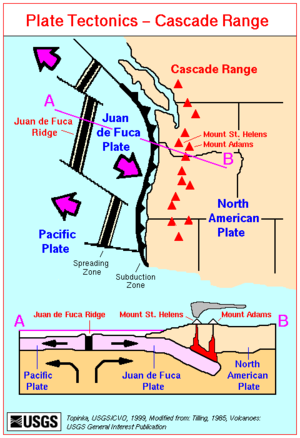
The early eruptive stages of Mount St. Helens are known as the "Ape Canyon Stage" (around 40–35,000 years ago), the "Cougar Stage" (ca. 20–18,000 years ago), and the "Swift Creek Stage" (roughly 13–8,000 years ago). The modern period, since about 2500 BC, is called the "Spirit Lake Stage". Collectively, the pre-Spirit Lake Stages are known as the "ancestral stages". The ancestral and modern stages differ primarily in the composition of the erupted lavas; ancestral lavas consisted of a characteristic mixture of dacite and andesite while modern lava is very diverse (ranging from olivine basalt to andesite and dacite).
St. Helens started its growth in the Pleistocene 37,600 years ago, during the Ape Canyon stage, with dacite and andesite eruptions of hot pumice and ash. 36,000 years ago a large mudflow cascaded down the volcano; mudflows were very significant forces in all of St. Helens' eruptive cycles. The Ape Canyon eruptive period ended around 35,000 years ago and was followed by 17,000 years of relative quiet. Parts of this ancestral cone were fragmented and transported by glaciers 14,000 to 18,000 years ago during the last glacial period of the current ice age.
The second eruptive period, the Cougar Stage, started 20,000 years ago and lasted for about 2,000 years. Pyroclastic flows of hot pumice and ash along with dome growth occurred during this period. Another 5,000 years of dormancy followed, only to be upset by the beginning of the Swift Creek eruptive period, typified by pyroclastic flows, dome growth and blanketing of the countryside with tephra. Swift Creek ended 8,000 years ago.
Smith Creek and Pine Creek eruptive periods
A dormancy of about 4,000 years was broken around 2500 BC with the start of the Smith Creek eruptive period, when eruptions of large amounts of ash and yellowish-brown pumice covered thousands of square miles. An eruption in 1900 BC was the largest known eruption from St. Helens during the Holocene epoch, judged by the volume of one of the tephra layers from that period. This eruptive period lasted until about 1600 BC and left 18-inch (46-cm)-deep deposits of material 50 miles (80 km) distant in what is now Mt. Rainier National Park. Trace deposits have been found as far northeast as Banff National Park in Alberta, and as far southeast as eastern Oregon. All told there may have been up to 2.5 cubic miles (10 km³) of material ejected in this cycle. Some 400 years of dormancy followed.
St. Helens came alive again around 1200 BC—the Pine Creek eruptive period. This lasted until about 800 BC and was characterized by smaller-volume eruptions. Numerous dense, nearly red hot pyroclastic flows sped down St. Helens' flanks and came to rest in nearby valleys. A large mudflow partly filled 40 miles (65 km) of the Lewis River valley sometime between 1000 BC and 500 BC.
Castle Creek and Sugar Bowl eruptive periods
The next eruptive period, the Castle Creek period, began about 400 BC, and is characterized by a change in composition of St. Helens' lava, with the addition of olivine and basalt. The pre-1980 summit cone started to form during the Castle Creek period. Significant lava flows in addition to the previously much more common fragmented and pulverized lavas and rocks ( tephra) distinguished this period. Large lava flows of andesite and basalt covered parts of the mountain, including one around the year 100 AD that traveled all the way into the Lewis and Kalama river valleys. Others, such as Cave Basalt (known for its system of lava tubes), flowed up to 9 miles (15 km) from their vents. During the first century, mudflows moved 30 miles (50 km) down the Toutle and Kalama river valleys and may have reached the Columbia River. Another 400 years of dormancy ensued.
The Sugar Bowl eruptive period was short and markedly different from other periods in Mount St. Helens history. It produced the only unequivocal laterally directed blast known from Mount St. Helens before the 1980 eruptions. During Sugar Bowl time, the volcano first erupted quietly to produce a dome, then erupted violently at least twice producing a small volume of tephra, directed-blast deposits, pyroclastic flows, and lahars.
Kalama and Goat Rocks eruptive periods
Roughly 700 years of dormancy were broken about 1480, when large amounts of pale gray dacite pumice and ash started to erupt, beginning the Kalama period. The eruption in 1480 was several times larger than the May 18, 1980 eruption. In 1482, another large eruption rivaling the 1980 eruption in volume is known to have occurred. Ash and pumice piled six miles (9.5 km) northeast of the volcano to a thickness of three feet (1 m); 50 miles (80 km) away, the ash was two inches (5 cm) deep. Large pyroclastic flows and mudflows subsequently rushed down St. Helens' west flanks and into the Kalama River drainage system.
This 150-year period next saw the eruption of less silica-rich lava in the form of andesitic ash that formed at least eight alternating light- and dark-colored layers. Blocky andesite lava then flowed from St. Helens' summit crater down the volcano's southeast flank. Later, pyroclastic flows raced down over the andesite lava and into the Kalama River valley. It ended with the emplacement of a dacite dome several hundred feet high at the volcano's summit, which filled and overtopped an explosion crater already at the summit. Large parts of the dome's sides broke away and mantled parts of the volcano's cone with talus. Lateral explosions excavated a notch in the southeast crater wall. St. Helens reached its greatest height and achieved its highly symmetrical form by the time the Kalama eruptive cycle ended, about 1647. 150 years of quiet returned to the volcano.
The 57-year Goat Rocks eruptive period started in 1800, and is the first time that both oral and written records exist. Like the Kalama period, the Goat Rocks period started with an explosion of dacite tephra, followed by an andesite lava flow, and culminated with the emplacement of a dacite dome. The 1800 eruption probably rivalled the 1980 eruption in size, although it did not result in massive destruction of the cone. The ash drifted northeast over central and eastern Washington, northern Idaho, and western Montana. There were at least a dozen reported small eruptions of ash from 1831 to 1857, including a fairly large one in 1842. The vent was apparently at or near Goat Rocks on the northeast flank.
Modern eruptive period
1980 to 2001 activity
On March 20, 1980, Mount St. Helens experienced a magnitude 5.1 earthquake. Steam venting started on March 27. By the end of April, the north side of the mountain started to bulge. With little warning, a second earthquake of the same magnitude on May 18 triggered a massive collapse of the north face of the mountain. It was the largest known debris avalanche in recorded history. The magma inside of St. Helens burst forth into a large-scale pyroclastic flow that flattened vegetation and buildings over 230 square miles (600 km²). On the Volcanic Explosivity Index scale, the eruption was rated a five (a Plinian eruption).
The collapse of the northern flank of St. Helens mixed with ice, snow, and water to create lahars (volcanic mudflows). The lahars flowed many miles down the Toutle and Cowlitz Rivers, destroying bridges and lumber camps. A total of 3.9 million cubic yards (3.0 million m³) of material was transported 17 miles (27 km) south into the Columbia River by the mudflows.
For more than nine hours, a vigorous plume of ash erupted, eventually reaching 12 to 16 miles (20 to 27 km) above sea level. The plume moved eastward at an average speed of 60 miles per hour (95 km/h), with ash reaching Idaho by noon.
By about 5:30 p.m. on May 18, the vertical ash column declined in stature, and less severe outbursts continued through the night and for the next several days. In all, St. Helens released energy equivalent to 350 megatons of dynamite; or 27,000 atomic blasts over Hiroshima; or seven times more than the strongest atomic bomb ever built and tested, the Tsar Bomba. It ejected more than 0.67 cubic miles (2.8 cubic km) of material. The removal of the north side of the mountain reduced St. Helens' height by about 1,300 feet (400 m) and left a crater one to two miles (1.6 to 3.2 km) wide and 0.5 mile (800 m) deep, with its north end open in a huge breach. The eruption killed 57 people, nearly 7,000 big game animals ( deer, elk, and bear), and an estimated 12 million fish from a hatchery. It destroyed or extensively damaged over 200 homes, 185 miles (300 km) of highway and 15 miles of railways.
Between 1980 and 1986, activity continued at Mount St. Helens, with a new lava dome forming in the crater. Numerous small explosions and dome-building eruptions occurred. With the winter snow of 1980-1981, a still-unnamed horse-shoe-shaped glacier began to evolve in the shadow of the crater. As of 2004, it covered about 0.36 square mile (0.93 km²). Until 2004's volcanic activity, it was considered the only growing glacier in the lower 48 United States. From December 7, 1989 to January 6, 1990, and from November 5, 1990 to February 14, 1991, the mountain erupted with sometimes huge clouds of ash.
2004 to present activity
Mount St. Helens became active again in the autumn of 2004, indicated initially by hundreds and then thousands of localized earthquakes, and followed by several significant emissions of steam and ash.
Magma reached the surface of the volcano about October 11, 2004, resulting in the building of a new lava dome on the existing dome's south side. This new dome continued to grow throughout 2005 and into 2006. A number of transient features were observed, such as the "whaleback", which comprised long shafts of solidified magma being exuded by the pressure of magma underneath it. These features are very fragile and break down soon after they are formed. On July 2, 2005, the tip of the whaleback broke off, causing a rockfall that sent ash and dust several hundred meters into the air. (see USGS before and after images)
Mount St. Helens showed significant activity on March 8, 2005, when a 36,000-foot (11,000 m) plume of steam and ash emerged—visible from Seattle. This relatively minor eruption was a release of pressure consistent with ongoing dome building. The release was accompanied by a magnitude 2.5 earthquake.
Another feature to grow from the dome is called the "fin" or "slab". Approximately half the size of a football field, the large, cooled volcanic rock was being forced upward as quickly as 6 feet (2 m) per day. In mid-June 2006, the slab was crumbling in frequent rockfalls, although it was still being extruded. The height of the dome was 7,550 feet (2,301 m), still below the height reached in July 2005 when the whaleback collapsed.
On October 22, 2006, at 3:13 p.m. PST, there was a magnitude 3.5 earthquake that broke loose Spine 7. There was a collapse and avalanche of the lava dome that sent an ash plume 2,000 feet over the western rim of the crater; the ash plume then rapidly dissipated.
